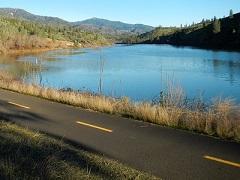Sacramento River Rail Trail improvement projects require temporary closures
Organization:
BLM Office:
Media Contact:
REDDING, Calif. – Crews from the Bureau of Land Management will be repairing fire damage and constructing fuel breaks along sections of the Sacramento River Rail Trail, requiring temporary closures on weekdays, from 6 a.m. until 5 p.m., now through May 21.
The first temporary closures are affecting the trail segment from the Rock Creek Trailhead to the Keswick Boat Launch through the week of May 3. A second access restriction will last 10 days, from May 10 to May 21, on the trail segment between the Keswick Dam Trailhead and the Rock Creek Trailhead.
The trail will be accessible all day on Saturdays and Sundays.
“We will be improving trail safety by removing dead trees and other vegetation and reducing wildfire risk by building fuel breaks and firefighter defensive zones,” said BLM Redding Field Manager Jennifer Mata. “This project is part of our continuing effort to recover from the Carr Fire and to improve fire resilience along this popular trail.”
The Sacramento River Rail Trail follows the route of a former rail line, extending from the Redding city limits north to Shasta Dam. The BLM manages the trail in partnership with the Bureau of Reclamation.
The trail is part of a network including more than 150 miles of trails for walkers, runners, hikers, bicyclists and horseback riders in the Redding Area. The BLM works closely with the city of Redding, Shasta County, the Bureau of Reclamation, the McConnell Foundation and the Redding Foundation to manage and improve the network.
The BLM manages about 245 million acres of public land located primarily in 12 western states, including Alaska, on behalf of the American people. The BLM also administers 700 million acres of sub-surface mineral estate throughout the nation. Our mission is to sustain the health, diversity, and productivity of America’s public lands for the use and enjoyment of present and future generations.

